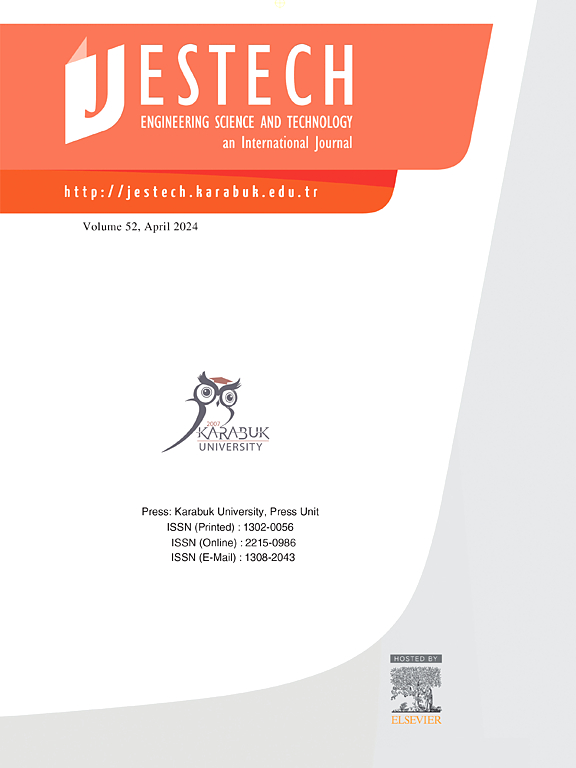通过混合风险优先级模型推进可持续造船:整合FMEA和机器学习
IF 5.4
2区 工程技术
Q1 ENGINEERING, MULTIDISCIPLINARY
Engineering Science and Technology-An International Journal-Jestech
Pub Date : 2025-07-28
DOI:10.1016/j.jestch.2025.102158
引用次数: 0
摘要
有效的风险管理对于生产复杂性不断增长的现代造船业至关重要。传统的失效模式和影响分析(FMEA)虽然被广泛使用,但往往缺乏客观性和可扩展性。本研究引入了一种新的混合方法,将FMEA与机器学习(ML),特别是随机森林(RF)回归相结合,以增强现实造船厂环境中的故障预测和缺陷优先级。该模型是在Cemre造船厂建造一艘lng动力渔船时记录的489个缺陷上进行训练的。每个缺陷都使用四个风险因素进行评估:成本、时间、频率和阶段。据此计算风险优先数(RPNs),并将其作为模型训练的目标值。该框架还结合了帕累托分析和特征重要性评估,以确定主要的风险贡献者。ML模型具有较高的预测准确度(决定系数(R2) = 0.9738;在当前操作条件下,平均绝对误差(MAE) = 1.3470。变形,不适当的生产和不良的零件使用被确定为最关键的类别。时间损耗和频率是影响rpn最显著的特征。改进场景显示了模型的鲁棒性和估计高优先级失效模式风险降低潜力的能力。这种混合方法将专家判断与数据驱动的智能连接起来,并为实时质量控制提供了可扩展的、客观的框架。它与企业系统集成的潜力意味着更广泛的工业应用,包括自动化风险监控和持续改进。结果表明,将FMEA与ML相结合可以显著推进船舶制造中的预测性缺陷管理。本文章由计算机程序翻译,如有差异,请以英文原文为准。
Advancing sustainable shipbuilding through a hybrid risk prioritization model: integrating FMEA and machine learning
Effective risk management is critical in modern shipbuilding, where production complexity continues to grow. Traditional Failure Modes and Effects Analysis (FMEA), despite its widespread use, often lacks objectivity and scalability. This study introduces a novel hybrid methodology that integrates FMEA with machine learning (ML), specifically, Random Forest (RF) regression, to enhance failure prediction and defect prioritization within a real-world shipyard context. The model was trained on 489 documented defects from the construction of an LNG-powered fishing vessel at Cemre Shipyard. Each defect was assessed using four risk factors: cost, time, frequency, and stage. Risk Priority Numbers (RPNs) were computed accordingly and used as target values in model training. The framework also incorporates Pareto analysis and feature importance evaluations to identify dominant risk contributors. The ML model achieved high predictive accuracy (Coefficient of Determination (R2) = 0.9738; Mean Absolute Error (MAE) = 1.3470) under current operational conditions. Deformation, inappropriate production, and defective part usage were identified as the most critical categories. Time loss and frequency emerged as the most significant features influencing RPNs. Improvement scenarios revealed the model’s robustness and capacity to estimate risk reduction potential for high-priority failure modes. This hybrid approach bridges expert judgment with data-driven intelligence and offers a scalable, objective framework for real-time quality control. Its potential for integration with enterprise systems suggests broader industrial applications, including automated risk monitoring and continuous improvement. The results demonstrate that combining FMEA with ML can significantly advance predictive defect management in maritime manufacturing.
求助全文
通过发布文献求助,成功后即可免费获取论文全文。
去求助
来源期刊

Engineering Science and Technology-An International Journal-Jestech
Materials Science-Electronic, Optical and Magnetic Materials
CiteScore
11.20
自引率
3.50%
发文量
153
审稿时长
22 days
期刊介绍:
Engineering Science and Technology, an International Journal (JESTECH) (formerly Technology), a peer-reviewed quarterly engineering journal, publishes both theoretical and experimental high quality papers of permanent interest, not previously published in journals, in the field of engineering and applied science which aims to promote the theory and practice of technology and engineering. In addition to peer-reviewed original research papers, the Editorial Board welcomes original research reports, state-of-the-art reviews and communications in the broadly defined field of engineering science and technology.
The scope of JESTECH includes a wide spectrum of subjects including:
-Electrical/Electronics and Computer Engineering (Biomedical Engineering and Instrumentation; Coding, Cryptography, and Information Protection; Communications, Networks, Mobile Computing and Distributed Systems; Compilers and Operating Systems; Computer Architecture, Parallel Processing, and Dependability; Computer Vision and Robotics; Control Theory; Electromagnetic Waves, Microwave Techniques and Antennas; Embedded Systems; Integrated Circuits, VLSI Design, Testing, and CAD; Microelectromechanical Systems; Microelectronics, and Electronic Devices and Circuits; Power, Energy and Energy Conversion Systems; Signal, Image, and Speech Processing)
-Mechanical and Civil Engineering (Automotive Technologies; Biomechanics; Construction Materials; Design and Manufacturing; Dynamics and Control; Energy Generation, Utilization, Conversion, and Storage; Fluid Mechanics and Hydraulics; Heat and Mass Transfer; Micro-Nano Sciences; Renewable and Sustainable Energy Technologies; Robotics and Mechatronics; Solid Mechanics and Structure; Thermal Sciences)
-Metallurgical and Materials Engineering (Advanced Materials Science; Biomaterials; Ceramic and Inorgnanic Materials; Electronic-Magnetic Materials; Energy and Environment; Materials Characterizastion; Metallurgy; Polymers and Nanocomposites)
 求助内容:
求助内容: 应助结果提醒方式:
应助结果提醒方式:


